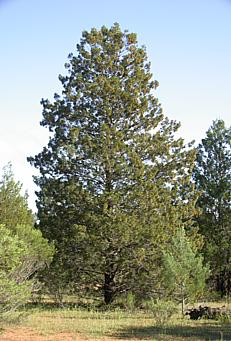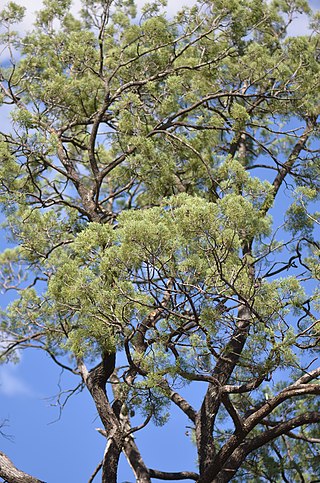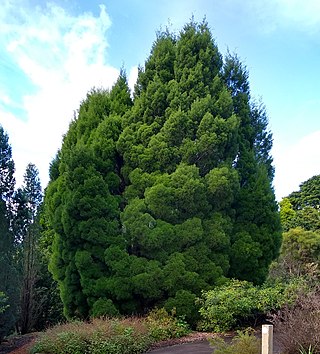Cypress is a common name for various coniferous trees or shrubs of northern temperate regions that belong to the family Cupressaceae. The word cypress is derived from Old French cipres, which was imported from Latin cypressus, the latinisation of the Greek κυπάρισσος (kyparissos). Cypress trees are a large classification of conifers, encompassing the trees and shrubs from the cypress family (Cupressaceae) and many others with the word cypress in their common name. Many cypress trees have needle-like, evergreen foliage and acorn-like seed cones.

Cupressus arizonica, the Arizona cypress, is a North American species of tree in the cypress family Cupressaceae, native to the southwestern United States and Mexico. Populations may be scattered rather than in large, dense stands.

Callitris is a genus of coniferous trees in the Cupressaceae. There are 16 recognized species in the genus, of which 13 are native to Australia and the other three native to New Caledonia. Traditionally, the most widely used common name is cypress-pine, a name shared by some species of the closely related genus Actinostrobus.

The Tasmanian pygmy possum, also known as the little pygmy possum or tiny pygmy possum, is the world's smallest possum. It was first described by Oldfield Thomas in 1888, after he identified that a museum specimen labelled as an eastern pygmy possum in fact represented a species then unknown to science. The holotype resides in the Natural History Museum in London.

Diselma archeri is a species of plant of the family Cupressaceae and the sole species in the genus Diselma. It is endemic to the alpine regions of Tasmania's southwest and Central Highlands, on the western coast ranges and Lake St. Clair. It is a monotypic genus restricted to high altitude rainforest and moist alpine heathland. Its distribution mirrors very closely that of other endemic Tasmanian conifers Microcachrys tetragona and Pherosphaera hookeriana.

Actinostrobus pyramidalis, commonly known as swamp cypress, Swan River cypress and King George's cypress pine, is a species of coniferous tree in the Cupressaceae. Like the other species in the genus Actinostrobus, it is endemic to southwestern Western Australia.

Callitris columellaris is a species of coniferous tree in the family Cupressaceae, native to most of Australia. Common names include white cypress, white cypress-pine, Murray River cypress-pine, and northern cypress-pine. Callitris columellaris has become naturalised in Hawaii and in southern Florida.

The eastern pygmy possum is a diprotodont marsupial of south-eastern Australia. Occurring from southern Queensland to eastern South Australia and also Tasmania, it is found in a range of habitats, including rainforest, sclerophyll forest, woodland and heath.

Actinostrobus arenarius is a species of conifer in the cypress family, Cupressaceae. Its common names include sandplain cypress, Bruce cypress, Bruce cypress-pine, and tamin. It is endemic to Western Australia.

Athrotaxis cupressoides, is also known as pencil pine, despite being a species of the family Cupressaceae, and not a member of the pine family. Found either as an erect shrub or as a tree, this species is endemic to Tasmania, Australia. Trees can live for upwards of 1000 years, sustaining a very slow growth rate of approximately 12 mm in diameter per year.

Callitris baileyi is a species of conifer in the family Cupressaceae. It is found only in Australia, more specifically Southeast Queensland. Its common English name is Bailey's cypress-pine. The name is dedicated to Australian botanist Frederick Manson Bailey, who was the first to collect specimens of this tree. Bailey's name is closely associated with much of the flora of Queensland and their elucidation in Southeastern Queensland. Over the past few decades the conifer has been severely threatened by habitat loss Fruiting for the species has been recorded year-round.

Callitris drummondii, or Drummond's cypress, is a species of conifer in the family Cupressaceae. It is found only in Western Australia. It is threatened by habitat loss.

Callitris endlicheri, commonly known as the black cypress pine, is a species of conifer in the family Cupressaceae. It is found only in Australia, occurring in Queensland, New South Wales, the Australian Capital Territory, and Victoria.

Callitris macleayana is a species of conifer in the family Cupressaceae, endemic to Australia. The tree is commonly known as stringybark pine, as well as brush cypress pine and Port Macquarie pine, although it does not belong to the pine genus or family. Stringybark pine is found in two regions of Australia's East coast, one in the centre and one in the North.

Callitris monticola, commonly known as the steelhead or dwarf cypress, is a species of conifer in the family Cupressaceae. It is found only in Australia, occurring in the states of Queensland and New South Wales and is considered vulnerable due to its restricted distribution.

Callitris muelleri is a species of conifer in the family Cupressaceae. It is found only in New South Wales, Australia.

Callitris preissii is a species of conifer in the family Cupressaceae, endemic to Rottnest Island, Australia. Common names include Rottnest Island pine, Murray pine, maroong, southern cypress pine, or slender cypress pine. The Noongar peoples know the tree as marro.

Callitris rhomboidea, commonly known as the Oyster Bay pine, Tasmanian cypress pine, Port Jackson pine, Illawarra mountain pine, or dune cypress pine, is a species of conifer in the family Cupressaceae. It is native to Australia, occurring in South Australia, Queensland, New South Wales, Victoria and Tasmania. It has become naturalized near Auckland, New Zealand and can be found on the island of Taillefer Rocks in Tasmania.

Callitris verrucosa, also known as the mallee pine, is a species of conifer in the family Cupressaceae. It is found only in Australia. The plant has a green/grey colour, rigid branches and can reach a height of 8 metres (26 ft). It has a slow grow rate.

The Athrotaxis selaginoides, a conifer endemic to Tasmania, is sensitive to temperature. The tree-ring chronologies developed from this species have shown distinct responses to temperature variations. In the southern sites, the ring width (RW) and earlywood (EW) are strongly related to cool season temperature (July–October). In contrast, in the northern sites, RW and EW are more strongly related to summer temperatures (December–February). This indicates that the growth of Athrotaxis selaginoides and its wood formation processes are influenced by temperature conditions.




















